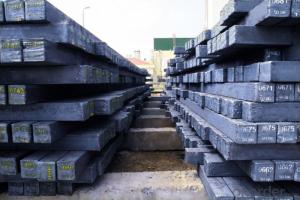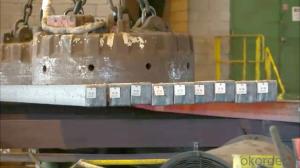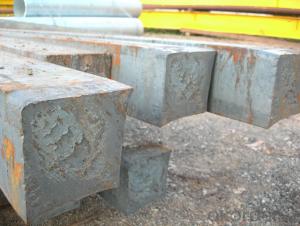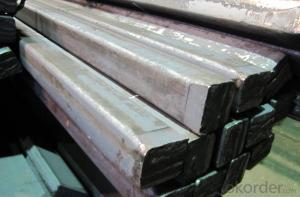Q235/3SP 140MM Blast Furnace Hot Rolled Steel Billet
- Loading Port:
- Tianjin
- Payment Terms:
- TT OR LC
- Min Order Qty:
- 2000 m.t.
- Supply Capability:
- 30000 m.t./month
OKorder Service Pledge
OKorder Financial Service
You Might Also Like
Description of Q235/3SP 140MM Blast Furnace Hot Rolled Steel Billet
Our hot dip galvanised steels consist of a steel substrate with a metallic zinc coating applied by means of a continuous hot dip galvanising process. Metallic zinc coatings are available in steel grades ranging from steel for bending and deep drawing applications, to structural steels and high yield strength steels.
A glossy surface finish obtained under specific skin-pass conditions (either non-skin-passed or skin- passed with smooth cylinders to obtain low roughness) can be provided if required at time of enquiry.
Advantage of Q235/3SP 140MM Blast Furnace Hot Rolled Steel Billet
Uncoated CR steel sheet With the features of in line with the international highest standards in demension and shape, excellent surface finish and properties, the products are mainly used in home appliance and automobile industries.
Galvanized steel sheet(include HDG and EG)
With the features of good corrosion resistance, the products are mainly used in automobile, home appliance, electronics, building and machinery manufacture industries, etc.
Precoated steel sheet With the features of enviromental protection and good processablility, long lasting surface durability, rich in colors, the products are maily used in building, home appliance and furniture industries, etc.
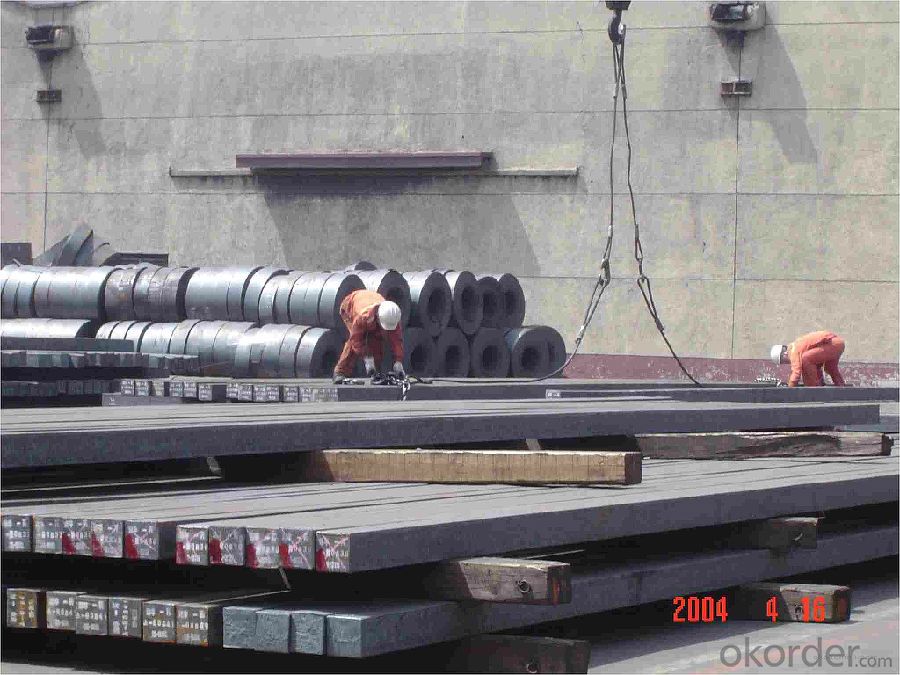
Applications of Q235/3SP 140MM Blast Furnace Hot Rolled Steel Billet
Our hot dip galvanised steels can be used in a very wide range of applications for industrial markets, both indoors and outdoors. Some of the most common applications are:
Building: wide sections for roofing and cladding, doors, door frames, metallic ceilings, partitions, structural members etc
Domestic appliances: all appliances for this sector (both white and brown goods) are manufactured with hot dip galvanised steels
Miscellaneous: electrical cabinets, aeraulic components, air conditioners, road signs etc
Zinc hot dip galvanised steel is suitable for contact with foodstuffs under certain conditions, as specified in European directive 89/109/EEC and French standard NF A 36-712-1. Please contact us for further information on this subject.
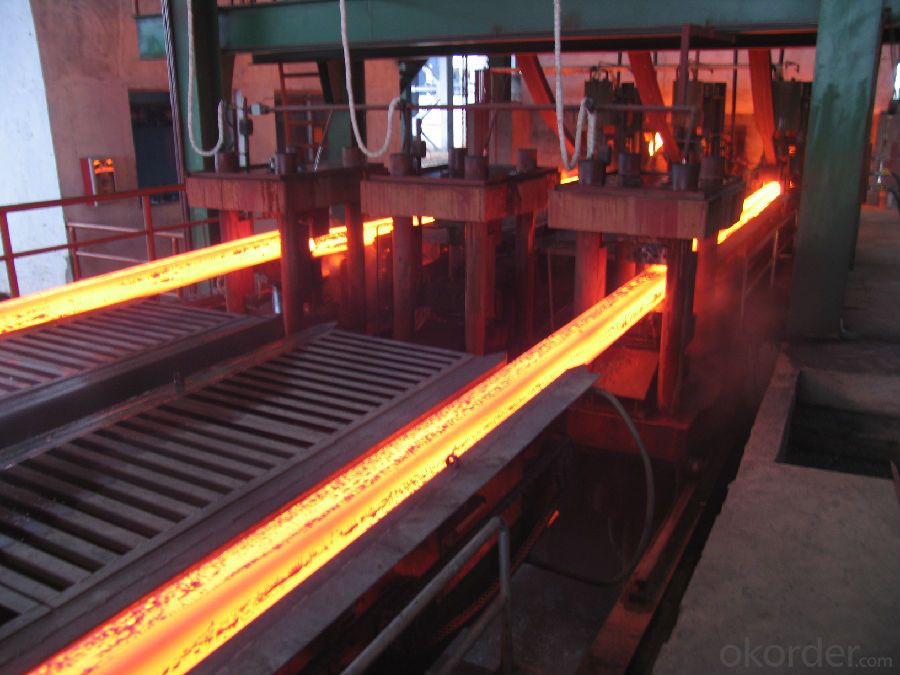
Specifications of Q235/3SP 140MM Blast Furnace Hot Rolled Steel Billet
Quality | Q/BQB 440-2003 | JIS G3312-1994 JIS G3321 | EN 10326-2004 | ASTM A653-02a |
EN 10327-2004 | (BASE PLATE) | |||
(BASE PLATE) | ||||
Commercial Steel | DC51D | SGCC SGLCC | DX51D+Z DX51D+AZ | CS Type A/B/C |
Forming Steel | St01,St02,St03 | SGCD1 SGLCD1 | FS Type A, Type B | |
Drawing | DC52D /DC53D | - | DX52D+Z DX52D+AZ | DDS TYPE A/C |
Steel | DX53D+Z DX53D+AZ | |||
Structural | S280GD (StE28) | SGC400 SGLC400 | S280D+Z DX54D+AZ | SS275 |
Steel | S350GD (StE34) | SGC440 SGLC440 | S350D+Z S350D+AZ | SS340 Class1 |
FAQ of Q235/3SP 85MM Blast Furnace Hot Rolled Steel Billet
We have organized several common questions for our clients,may help you sincerely:
1. How Can I Visit There?
Our company is located in Tianjin City, China, near Beijing. You can fly to Tianjin Airport Directly. All our clients, from home or aboard, are warmly welcome to visit us!
2. How Can I Get Some Sample?
We are honored to offer you sample.
3. Why choose CNBM?
Our delivery time about 15-20days for standard sizes, if you have other requirements like hardness, quanity and width ,it is about 20-40days. But don't worry we also try our best for the delivery time ,because time longer and our cost is higher.
- Q:What are the different methods of corrosion protection for steel billets?
- There are various methods available for corrosion protection of steel billets. Some of the common methods include: 1. Coating: Applying a protective coating on the surface of steel billets is one of the most effective methods of corrosion protection. This can be achieved through processes such as hot-dip galvanizing, painting, or applying a protective film. The coating acts as a barrier between the steel surface and corrosive elements in the environment, preventing direct contact and reducing the likelihood of corrosion. 2. Cathodic Protection: This method involves creating an electrochemical reaction to protect the steel billets from corrosion. Cathodic protection can be achieved by either using sacrificial anodes or by applying an impressed current. Sacrificial anodes, typically made of zinc or magnesium, are connected to the steel billets, and they corrode sacrificially instead of the steel, thus protecting it. Impressed current systems use an external power source to provide the necessary current to protect the steel. 3. VCI (Volatile Corrosion Inhibitors): VCI is a method that involves using chemicals that release vapors to create a protective layer on the steel surface. These chemicals inhibit the corrosion process by neutralizing the corrosive agents or forming a protective film on the steel surface. VCI can be applied through various methods, such as coating, wrapping, or inserting VCI paper or packets into the packaging of steel billets. 4. Alloying: Introducing alloying elements into the composition of steel billets can significantly improve their corrosion resistance. For example, adding chromium or nickel can enhance the stainless properties of steel, making it more resistant to corrosion. Alloying can be done during the initial production of steel billets or through post-treatment processes. 5. Environmental Control: Controlling the environment in which steel billets are stored or used is also crucial in preventing corrosion. This includes measures such as maintaining proper humidity levels, avoiding exposure to corrosive chemicals or gases, and minimizing contact with water or moisture. By controlling the environment, the likelihood of corrosion can be reduced, thereby protecting the steel billets. It is important to note that the choice of corrosion protection method depends on various factors, including the anticipated level of exposure to corrosive elements, the intended use of the steel billets, and cost considerations. Therefore, it is advisable to consult with corrosion experts or engineers to select the most suitable method for a particular application.
- Q:How are steel billets used in the manufacturing of pressure vessel components?
- Steel billets are a crucial raw material in the manufacturing process of pressure vessel components. Pressure vessels are containers designed to hold gases or liquids at a significantly higher or lower pressure than the surrounding environment. These components are widely used in various industries such as oil and gas, chemical, and power generation. Steel billets, which are semi-finished products with a square or round cross-section, serve as the starting point for the production of pressure vessel components. They are typically made from carbon or alloy steel and undergo several manufacturing processes to transform them into the final product. The first step in the manufacturing process involves heating the steel billets to a specific temperature to make them more malleable. This process is known as hot working or forging. The heated billets are then subjected to pressure, either through hammering or rolling, to shape them into the desired form. This process helps to refine the structure of the steel and improve its mechanical properties. After the initial shaping process, the billets are further processed through a series of machining operations. This includes cutting, drilling, and milling to create the necessary features and dimensions required for pressure vessel components such as shells, heads, nozzles, and flanges. These machining operations ensure that the components meet the precise specifications and tolerances required for safe and efficient operation. Additionally, the steel billets may undergo heat treatment processes such as annealing, quenching, and tempering to further enhance their mechanical properties. Heat treatment helps to improve the strength, hardness, and durability of the steel, making it suitable for withstanding high pressures and corrosive environments. Once the pressure vessel components are machined and heat-treated, they undergo rigorous quality control inspections to ensure they meet the required standards and specifications. This includes non-destructive testing methods such as ultrasonic testing, radiographic testing, and liquid penetrant testing to detect any potential defects or flaws. In summary, steel billets play a crucial role in the manufacturing of pressure vessel components. They are transformed through hot working, machining, and heat treatment processes to create the final products. By using high-quality steel billets and employing stringent quality control measures, manufacturers can produce pressure vessel components that are safe, reliable, and capable of withstanding the demanding conditions they are designed for.
- Q:What are the potential defects or flaws in steel billets?
- Steel billets may experience various defects or flaws that can impact the final product's quality and performance. Some of these defects include the following: 1. Surface imperfections: During manufacturing, steel billets may develop surface cracks, scales, or scratches. These imperfections can weaken the material and compromise its structural integrity. 2. Internal flaws: Inclusions, such as non-metallic impurities or gas bubbles, may be present within the steel billets. These internal flaws can create localized weaknesses and reduce the overall material strength. 3. Segregation: Uneven distribution of alloying elements or impurities can result in segregation, where different areas of the billet have varying chemical compositions. Segregation can lead to inconsistent mechanical properties and decrease material uniformity. 4. Central segregation: This defect occurs when impurities or alloying elements concentrate in the central region of the billet, resulting in a weaker core. Central segregation can cause structural failures and decrease the overall reliability of the steel billet. 5. Shrinkage cavities: During solidification, the contraction of molten metal can lead to the formation of shrinkage cavities in the steel billet. These cavities can weaken the material and compromise its structural integrity. 6. Surface decarburization: High temperatures or improper heat treatment can cause the surface of the steel billet to lose carbon content, resulting in surface decarburization. This defect can reduce the material's hardness and strength. 7. Laminations: Thin, elongated voids or layers known as laminations can form parallel to the billet's surface. These defects can weaken the material and make it susceptible to cracking or failure under stress. 8. Internal fissures: Improper cooling or handling during manufacturing can lead to internal fissures or cracks. These cracks can jeopardize the structural integrity of the steel billet and potentially lead to catastrophic failure. It is crucial to detect and address these defects early on to ensure the quality and reliability of the steel billets. Several non-destructive testing techniques, such as ultrasonic testing or magnetic particle inspection, can be employed to identify and mitigate these potential flaws.
- Q:What are the different types of steel billet welding processes?
- Various industries commonly use several different types of steel billet welding processes. These processes include the following: 1. SMAW (Shielded Metal Arc Welding), also known as stick welding, utilizes a flux-coated electrode that is manually fed into the welding pool. It is a versatile and widely employed method for welding steel billets. 2. GMAW (Gas Metal Arc Welding), commonly referred to as MIG welding, involves a continuously fed wire electrode and a shielding gas to protect the weld pool. Due to its efficiency and ease of use, it is a popular choice for welding steel billets. 3. FCAW (Flux-Cored Arc Welding) is similar to GMAW, but instead of a solid wire, it uses a tubular electrode filled with flux. This process is often favored for outdoor or windy conditions due to the flux's superior protection against atmospheric contamination. 4. SAW (Submerged Arc Welding) entails feeding a consumable electrode and a granular flux into the weld zone, while the arc remains submerged beneath a layer of flux. It is commonly applied for welding large steel billets because of its high deposition rates and deep penetration capabilities. 5. GTAW (Gas Tungsten Arc Welding), also known as TIG welding, utilizes a non-consumable tungsten electrode and a shielding gas to safeguard the weld pool. This precise and high-quality welding process is suitable for thin steel billets or applications that require exceptional weld aesthetics. 6. ESW (Electroslag Welding) is a highly efficient process employed for welding thick steel billets. It involves melting a consumable electrode and the base metal in a molten slag pool, which provides protection and acts as a filler material. 7. LBW (Laser Beam Welding) utilizes a high-energy laser beam to melt and join steel billets together. It is a precise and fast welding process commonly used in industries such as automotive and aerospace. Each of these welding processes has its own advantages and limitations. The choice of process depends on factors such as the type and thickness of the steel billet, desired weld quality, production requirements, and cost considerations.
- Q:What are the properties of high-quality steel billets?
- High-quality steel billets possess several key properties that make them desirable for various applications. First and foremost, these billets have a high level of purity, meaning they contain minimal impurities such as sulfur, phosphorus, and other non-metallic elements. This purity contributes to the overall strength and performance of the steel. Another important property of high-quality steel billets is their uniform internal structure. This means that the grains within the billet are evenly distributed, resulting in consistent mechanical properties throughout the material. This uniformity enhances the strength, toughness, and durability of the steel. High-quality steel billets also exhibit excellent dimensional accuracy. They have precise and consistent dimensions, which are crucial for subsequent processing and manufacturing operations. This dimensional accuracy ensures that the billets can be easily formed, rolled, forged, or machined into their intended final shapes. Furthermore, high-quality steel billets possess superior surface finish. They are free from defects such as cracks, voids, or inclusions on their surfaces. This smooth and defect-free surface allows for better heat transfer, improved corrosion resistance, and enhanced aesthetic appearance of the final steel products. Lastly, high-quality steel billets exhibit excellent metallurgical properties. They have a well-controlled chemical composition, which determines their specific mechanical and physical characteristics. These properties can be tailored to meet the requirements of different applications, such as high strength, high ductility, or resistance to extreme temperatures. In summary, high-quality steel billets possess properties such as purity, uniform internal structure, dimensional accuracy, excellent surface finish, and desirable metallurgical properties. These properties make them ideal for a wide range of applications, including construction, automotive, aerospace, and manufacturing industries.
- Q:What are the properties of steel billets?
- Steel billets are semi-finished metal products that possess several key properties. They are typically made from carbon steel and have a rectangular or square cross-section. Steel billets exhibit high strength, durability, and ductility, making them suitable for various industrial applications. They can be easily shaped or machined into different forms, including bars, rods, or sheets. Moreover, steel billets have excellent weldability and can withstand high temperatures, making them ideal for construction, automotive, and manufacturing industries.
- Q:How are steel billets used in the manufacturing of springs?
- Steel billets are used in the manufacturing of springs by being heated and then forged or rolled into the desired shape and size. These billets serve as the raw material for producing high-quality springs, providing the necessary strength and durability required for various applications.
- Q:How do steel billets contribute to sustainable construction?
- Steel billets contribute to sustainable construction in several ways. Firstly, steel is a highly durable and long-lasting material, which means that structures made from steel billets have a longer lifespan and require less maintenance and repair over time. This reduces the need for frequent reconstruction and minimizes waste generation. Secondly, steel is a recyclable material, and steel billets can be easily melted down and reused in the production of new steel products without losing their quality. This reduces the demand for raw materials and energy consumption, reducing the environmental impact of construction. Furthermore, steel is known for its strength and load-bearing capacity, allowing for the design of lighter and more efficient structures. This not only reduces the amount of steel required in construction but also decreases the overall weight of the building, which can lead to energy savings during transportation and construction. Lastly, steel is resistant to pests, such as termites, and is not susceptible to rot or decay. This eliminates the need for chemical treatments and preservatives, making it a safer and more sustainable choice for construction. Overall, steel billets contribute to sustainable construction by promoting durability, recyclability, energy efficiency, and reduced environmental impact.
- Q:What are the weight ranges of steel billets?
- The weight of steel billets can vary based on the industry's specific requirements and standards. Generally, steel billets can weigh anywhere from a few kilograms to several metric tons. The weight of a steel billet is determined by factors like its dimensions, intended application, and production process. Smaller steel billets, used in construction or manufacturing, typically weigh between 1 to 10 kilograms. Conversely, larger steel billets, commonly utilized in heavy machinery or infrastructure projects, can weigh anywhere from 10 to 100 metric tons or potentially more. It is important to note that these weight ranges are approximate estimates and may differ depending on the particular industry requirements and production capabilities.
- Q:What are the challenges in welding steel billets?
- Some challenges in welding steel billets include ensuring proper joint preparation and alignment, managing heat input and distortion, selecting suitable filler materials, and controlling the formation of defects such as porosity, cracking, or incomplete fusion. Additionally, the high carbon content in certain steel billets can make them prone to hardening and cracking during the welding process, requiring specific preheating and post-weld heat treatment procedures.
1. Manufacturer Overview |
|
|---|---|
| Location | |
| Year Established | |
| Annual Output Value | |
| Main Markets | |
| Company Certifications | |
2. Manufacturer Certificates |
|
|---|---|
| a) Certification Name | |
| Range | |
| Reference | |
| Validity Period | |
3. Manufacturer Capability |
|
|---|---|
| a)Trade Capacity | |
| Nearest Port | |
| Export Percentage | |
| No.of Employees in Trade Department | |
| Language Spoken: | |
| b)Factory Information | |
| Factory Size: | |
| No. of Production Lines | |
| Contract Manufacturing | |
| Product Price Range | |
Send your message to us
Q235/3SP 140MM Blast Furnace Hot Rolled Steel Billet
- Loading Port:
- Tianjin
- Payment Terms:
- TT OR LC
- Min Order Qty:
- 2000 m.t.
- Supply Capability:
- 30000 m.t./month
OKorder Service Pledge
OKorder Financial Service
Similar products
New products
Hot products
Related keywords

